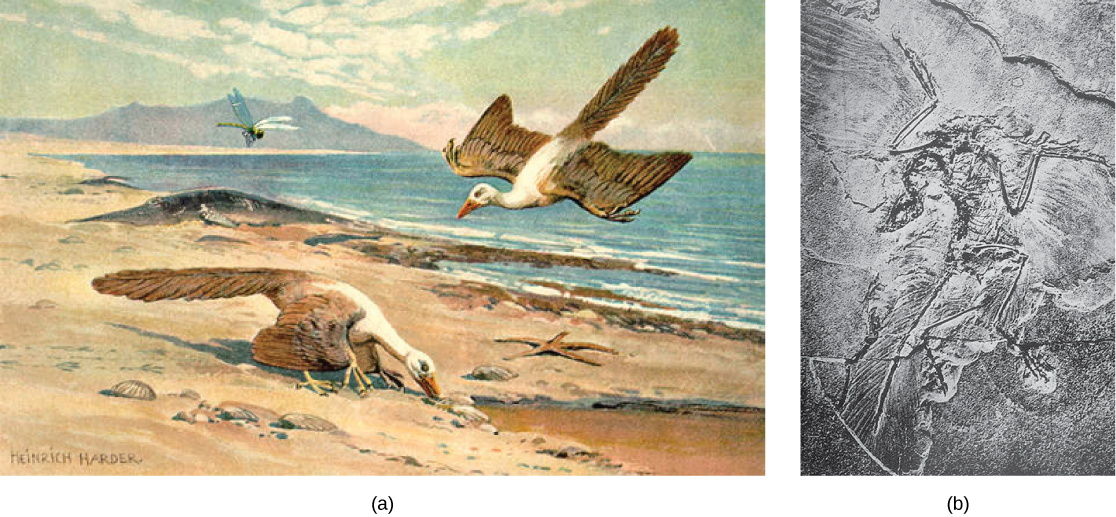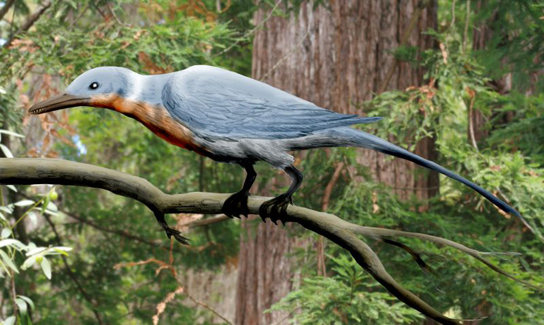| << Chapter < Page | Chapter >> Page > |

It is still unclear exactly how flight evolved in birds. Two main theories exist, the arboreal (“tree”) hypothesis and the terrestrial (“land”) hypothesis. The arboreal hypothesis posits that tree-dwelling precursors to modern birds jumped from branch to branch using their feathers for gliding before becoming fully capable of flapping flight. In contrast to this, the terrestrial hypothesis holds that running was the stimulus for flight, as wings could be used to improve running and then became used for flapping flight. Like the question of how flight evolved, the question of how endothermy evolved in birds still is unanswered. Feathers provide insulation, but this is only beneficial if body heat is being produced internally. Similarly, internal heat production is only viable if insulation is present to retain that heat. It has been suggested that one or the other—feathers or endothermy—evolved in response to some other selective pressure.
During the Cretaceous period, a group known as the Enantiornithes was the dominant bird type ( [link] ). Enantiornithes means “opposite birds,” which refers to the fact that certain bones of the feet are joined differently than the way the bones are joined in modern birds. These birds formed an evolutionary line separate from modern birds, and they did not survive past the Cretaceous. Along with the Enantiornithes, Ornithurae birds (the evolutionary line that includes modern birds) were also present in the Cretaceous. After the extinction of Enantiornithes, modern birds became the dominant bird, with a large radiation occurring during the Cenozoic Era. Referred to as Neornithes (“new birds”), modern birds are now classified into two groups, the Paleognathae (“old jaw”) or ratites, a group of flightless birds including ostriches, emus, rheas, and kiwis, and the Neognathae (“new jaw”), which includes all other birds.

Veterinarians are required to complete a degree in veterinary medicine, which includes taking courses in animal physiology, anatomy, microbiology, and pathology, among many other courses. The physiology and biochemistry of different vertebrate species differ greatly.
Veterinarians are also trained to perform surgery on many different vertebrate species, which requires an understanding of the vastly different anatomies of various species. For example, the stomach of ruminants like cows has four compartments versus one compartment for non-ruminants. Birds also have unique anatomical adaptations that allow for flight.
Some veterinarians conduct research in academic settings, broadening our knowledge of animals and medical science. One area of research involves understanding the transmission of animal diseases to humans, called zoonotic diseases. For example, one area of great concern is the transmission of the avian flu virus to humans. One type of avian flu virus, H5N1, is a highly pathogenic strain that has been spreading in birds in Asia, Europe, Africa, and the Middle East. Although the virus does not cross over easily to humans, there have been cases of bird-to-human transmission. More research is needed to understand how this virus can cross the species barrier and how its spread can be prevented.
Birds are endothermic, meaning they produce their own body heat and regulate their internal temperature independently of the external temperature. Feathers not only act as insulation but also allow for flight, providing lift with secondary feathers and thrust with primary feathers. Pneumatic bones are bones that are hollow rather than filled with tissue, containing air spaces that are sometimes connected to air sacs. Airflow through bird lungs travels in one direction, creating a cross-current exchange with the blood. Birds are diapsids and belong to a group called the archosaurs. Birds are thought to have evolved from theropod dinosaurs. The oldest known fossil of a bird is that of Archaeopteryx , which is from the Jurassic period. Modern birds are now classified into two groups, Paleognathae and Neognathae.

Notification Switch
Would you like to follow the 'Biology' conversation and receive update notifications?